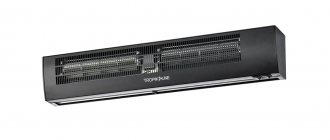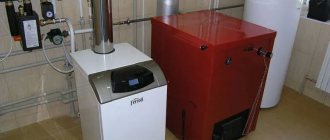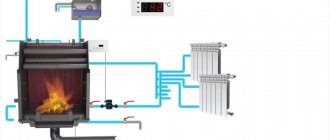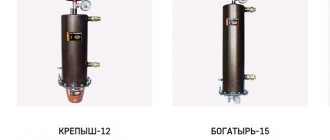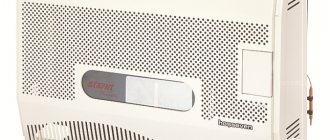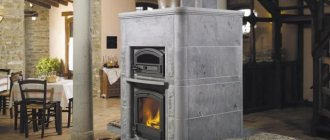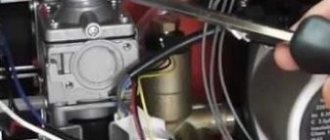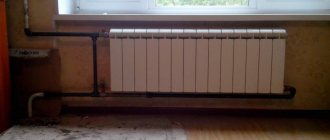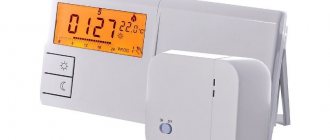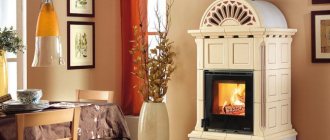Here you will learn:
- Electric convectors and their main types
- Popular models of electric convectors
- Reviews about electric convectors
When choosing electrical heating equipment to heat our home, we strive to purchase equipment that would suit us in all respects. The same applies to electric convectors, which are actively used for heating houses. In this article, we decided to consider all types of electric convectors so that you can make the right choice and purchase the equipment that is optimal in terms of characteristics and properties. We will conclude with user feedback.
Heat sources
To heat a living space, a person uses different heat sources. The most common was hot water circulating in a closed kennel from pipes laid throughout the house.
But the water still needs to be heated before being fed into the pipes. For this purpose, centralized heat supply is used in multi-storey buildings.
In this case, there is a separate boiler plant, where combustion of gas or coal is used for heating.
In private homes, autonomous gas heating is more often used, where a small gas boiler is used to heat water, providing heat only to the house in which it is installed.
It’s just that with centralized heating, certain deadlines are set for providing heat to the house, and the heat supply itself wants to leave the best.
In the private sector, there are times when the house is cool and you don’t want to start the boiler.
In this case, electric heaters come to the rescue. Although they consume a significant amount of electricity, since they have significant power, they are able to quickly heat any room in the house.
There are a large number of types of electric heaters, from simple spiral heaters, popularly nicknamed “goats,” to modern infrared and convector heaters.
The latter are becoming increasingly popular these days.
Convector heater design
The electric convector is externally made in the form of a rectangular structure of small thickness, with a horizontally oriented grille on top of the front side, and another similar grille, but at the bottom of the back side.
The heater control unit is located at the end of the top or side part.
Inside the convector body there is a heating element with a diffuser, a control board and a temperature sensor.
Moreover, the heating element and diffuser are located in the lower part, and the board is located at the top. This is the whole filling of such a heater.
The control board additionally includes a thermostat that allows you to maintain the temperature in the room, as well as a fuse that controls the operating temperature of the device and provides emergency shutdown in case of overheating.
Designs of convector heaters.
Convectors use several heaters of different designs.
The simplest are needle-type heating elements. They have a plate on which a nickel thread is attached in the form of loops.
There are also tubular heating elements in which the heating element is located inside the tube.
The best are monolithic heaters that use a sealed tube filled with magnesite.
The diffuser consists of aluminum plates installed along the entire length of the heating element tube. Its task is to ensure better heat transfer by increasing the area of the heating element.
The temperature sensor is located near the bottom grill. The sensor itself is very sensitive and is capable of detecting a temperature change of even 0.1 degrees. WITH.
What is important to remember
The use of a convector from any manufacturer in everyday life requires full compliance with all safety rules.
Here are the most important recommendations that everyone should learn to use a convector:
- It is forbidden to cover the electric convector with anything, and it is also forbidden to dry things on the device.
- Electric convectors with a thermostat must be installed correctly, especially built-in models. Therefore, before direct installation, read the instructions from the manufacturer, which are always included in the kit.
- Do not place the heater near an electrical outlet. The minimum distance to the socket should be 1 meter.
- For wet rooms, you should buy electric convectors with o, this means that the devices can work effectively in wet rooms.
We advise you to buy only high-quality electrical appliances from trusted manufacturers. Convectors at a suspiciously low price may turn out to be of poor quality - and you will greatly regret this purchase in the future.
Principle of operation
The operation of this heater is based on the ability of air to rise upward when heated.
In a convector, this property is implemented as follows: cold air located at the bottom of the room enters the convector through the lower grille.
Passing through the heating element with a diffuser, the air heats up and rises upward, where it exits through the upper grille.
Hot air rushes upward and displaces cooler air, which falls down and enters the convector.
In this way, air is circulated through the convector, which ensures constant heating of the air, and as a result, the temperature in the room.
Additionally, heat exchange is carried out by the convector body itself. The air, rising up inside the housing, heats it, and it subsequently gives off heat to the external environment.
This design is good because even with maximum heating, the walls of the case do not heat up too much, which ensures safety.
The temperature to which the air should be heated when passing through the convector heater is set on the control unit.
The principle of the device
If we talk about design features, then the wall convector includes a housing, a heating element (closed type), a thermostat and temperature sensors and switching off the device in case of overheating. Let's look at the elements of the device in more detail.
Prices for electric convector
electric convector
Convector device diagram
First of all, the body itself is important. Usually this is a box made of thin aluminum, steel or high-strength plastic (less commonly). The light weight of the housing allows you to install the device on any wall, even with large dimensions of the convector. Such a housing is similar to a vertical pipe, where the temperatures at the inlet and outlet differ significantly. This contributes to high draft, and therefore strong convection air flow.
There are brackets on the back of the device panel that allow you to easily hang the convector on the wall.
Bonjour CEG FN-meca 500 W
Interesting: some devices may be equipped with additional wheels. This makes them not only convenient to place, but also very mobile.
So, at the bottom of the convector there are inlets where cold air enters. Depending on the model, the lower part can have either windows or one long opening. There is also a temperature sensor at the entrance. It is responsible for turning the heating element on and off: when the desired temperature is reached, the device will stop heating the air. And vice versa, as soon as the incoming air masses are recognized by the sensor as not warm enough, the heating element is turned on and the convector operation continues. This is very convenient and significantly saves electricity consumption.
Cold air enters the device through the lower openings, and warm air exits from the upper ones.
The cold air that gets inside becomes warm due to the operation of the heating element. There may be several of these in a convector. The heating elements are different in different models: they can be spirals, modules - anything.
There are exit holes at the top of the device. This is where the heated air is directed, and from there it enters the room. Some convectors are equipped with small curtains, with which you can change the direction of warm air masses.
The device is controlled as standard: by a switch. Each is equipped with indicators and a thermostat, and some have various additional functions.
Expert opinion: Masalsky A.V.
Editor of the “construction” category on the Stroyday.ru portal. Specialist in engineering systems and drainage.
As a rule, there is another very important “helper” inside the convector. This is a temperature sensor that protects the device from unplanned strong heating. This protection system is very effective: if the temperature rises excessively, the power to the convector is turned off.
Important: situations like this are not uncommon. Often users themselves contribute to the disruption of air mass circulation. Such interference includes various objects that interfere with the operation of the device (for example, some kind of thing), or the accumulation of dust.
Some devices are not equipped with a thermostat, but it can be purchased separately.
This principle of constructing a wall-mounted convector is classic; it is typical for almost any similar device. There are models with a different design and more equipment.
Video - Operating principle of an electric convector
Advantages and disadvantages
Electric convectors have enough advantages. Its first and most important advantage is high efficiency; the convector provides this indicator at 95%.
In addition, positive qualities also include:
- Easy to install and use. All you need to do is place it next to the outlet, connect it to it and set the temperature;
- The design of such a convector is very simple, which ensures high reliability. The average service life of a convector is approximately 15 years. At the same time, it requires minimal maintenance - periodic cleaning of the device from dust;
- The presence of a thermostat in the design ensures automatic maintenance of the temperature in the room, without human intervention. When the desired temperature in the room is reached, it turns off. As soon as the temperature drops, the convector turns on. Moreover, the convector is guided by the temperature in the lower part of the room, that is, by the cold air. Therefore, the temperature sensor is located at the bottom of the convector;
- The design of such a convector has no moving parts, which ensures silent operation. The only source of noise can be a thermostat, made in the form of a mechanical relay. When activated, such a thermostat will create a clicking sound when the contacts close. Electronic thermostats do not make any sounds;
- These heating devices begin to provide heat to the room almost immediately after being plugged in, and are able to quickly heat the air in the room;
- Safety of use. Even at maximum performance, the heater body, which also participates in heat exchange, does not heat up to such a temperature that can cause a burn to a person. A fuse protects the device from overheating.
Flaws.
However, convector heaters also have disadvantages. Although they are few and far between, they exist.
So, the disadvantages of convectors include:
- Significant energy consumption. Although this indicator largely depends on the thermal insulation of the room. With strong heat losses due to drafts, poor insulation of walls and windows, energy consumption will be high, but if thermal insulation is at the proper level, energy consumption will not be particularly high;
- It will not be economically feasible to heat large rooms with convectors. They are more suitable for local heating. That is, they are best used either in small rooms or as a supplement to centralized heating;
- Convector heaters, although they do not heat the air to significant temperatures, still dry it out somewhat. Therefore, when using such devices, it is better to worry about air humidification in advance;
- Even without moving parts, the convector is capable of spreading dust throughout the room. It does this because the air circulates during its operation due to heating, and therefore moves small dust particles.
We recommend reading - how to choose electric heating boilers.
TOP 5 best electric convectors
Now let's look at what are the best convectors offered by modern industry.
The review presents a rating of 5 models. They are approximately equal in basic technical parameters.
NeoClima Fast 2000
1 199 ₱
If you choose an inexpensive but reliable device, then NeoClima Fast 2000 is just for you.
The device is connected to an alternating current network of 220V with energy consumption up to 2000 W/hour.
This power is optimal for rooms up to 20 m².
Two heating elements with low inertia and high heat transfer make it possible to quickly warm up the room.
The installed mechanical regulator controls three power levels up to a lower limit of 750 W. There is an overheating protection system with automatic shutdown of the convector.
Due to the built-in anti-freeze system, it can be used in basements.
The light weight of the device - 2 kg - makes it easy to move the device from one place to another.
Timberk TEC.E3 M 2000
from 3,240 to 6,385 ₱
Our rating continues with the safe heater Timberk TEC.E3 M 2000. A good substitute for central heating during seasonal preventive shutdowns of central heating.
It heats up the room quickly. Doesn't make noise when heating up. The set includes legs for floor positioning and dowels for wall mounting.
A room of 16 m² begins to warm up 2 minutes after switching on. A comfortable room temperature of +25° is achieved quite quickly - in 25 minutes.
The thermal relay allows you to select several options (out of three) operating modes.
It is worth considering the quality of the metal of the case - it is quite soft, but at the same time, in addition to floor placement, it also has the ability to be wall mounted.
Noirot Spot E-3 Plus 1500
10 890₱
Yes, the price of the device has increased. But it's justified. The device is also included in the rating of the best heating heaters, because the heating of the room is arranged in such a way that the heat distribution occurs very evenly.
And at the same time, the Spot E-3 Plus 1500 model is a very economical heater. It contains an electronic digital ASIC® thermostat with the ability to maintain a given temperature with an accuracy of 0.1 °C. Due to such precise adjustment of the temperature balance, significant savings occur in energy resources. And this, in turn, has a positive effect on increasing the service life of the device with the highest possible level of comfort in the room without sudden changes in temperature.
The device is universal and at the same time low noise. Can be installed on the floor or hung on a bracket to the wall.
If you have doubts about which convector to choose, think about Noirot. There are no sharp corners on which children can get hurt and, importantly, they can’t get burned on it either. The maximum temperature of the outer walls does not exceed 600C.
There are three operating modes:
- heating;
- cooling;
- drainage.
The heater has built-in electronic automation with protection against sudden voltage changes (from 150 V to 242 V). If there is a sudden power outage, there is an automatic restart function.
The device is intended for domestic use, so a special connection to an electrical network with grounding is not required. At the same time, it has class 2 electrical protection, which allows uninterrupted operation 24 hours a day!
When purchasing, there is no doubt about which company to buy the heater from. Manufacturer: France and this already says a lot.
Ballu BEC/EZER-1500
4 511 ₱
In order to make sure which convector is better, we continue our rating of home heaters. Here is the electric convector Ballu Enzo BEC/EZER-1500.
This is also a floor-wall modification. Electronic heating control with a high-precision thermostat is one of the main advantages of this heater. High energy efficiency is achieved through the built-in Homogeneous flow system with Intake air intakes.
There is a function - parental control, supplemented by a sleep timer. There is also an Auto Restart function that automatically turns on the device if there is a sudden power outage. All current settings are retained after disconnection.
An accurate thermostat allows you to economically and efficiently heat a room up to 20 m².
There are also “goodies” from the Ballu concern:
- Moisture protection.
- Overheat protection.
- Light indication.
- Heater control blocking.
- Flip sensor.
- Ionizer
- Built-in timer.
If the room temperature exceeds 20 °C, the device will not turn on at full load. Therefore, this model can be installed as an additional heat source.
Electrolux ECH/AS-2000 MR
6 290₱
And the Russian Electrolux ECH/AS-2000 MR closes our rating of electric convectors.
Perhaps this is the best balance between price and quality.
Electrolux is equipped with an X-shaped monolithic heating element with a power of 2000 W, which allows the convector to instantly heat a room of up to 25 m². What oil radiators cannot boast of.
It is easy to control - there is a built-in mechanical thermostat that allows you to select the heating level of 1000 or 2000 W.
It is safe to use as it has built-in tip-over protection. And the built-in three-stage dust filter does a good job of cleaning and ionizing the air.
For floor use it is equipped with plastic wheels, although it is possible to mount it permanently on a wall.
In terms of moisture protection, it is suitable for placement in bathrooms.
Types of convector heaters
Structurally, all convector heaters are very similar, but several types are produced - wall-mounted, free-standing, floor-mounted and for rooms with high humidity.
They can be divided into high ones - with a height of up to 650 mm, and low ones - up to 200 mm.
Wall-mounted and free-standing are classified as high. The difference between them comes down to the fact that wall-mounted ones are equipped with lugs for mounting on the wall, making them stationary and providing heating only for the room where they are installed.
Free-standing - they have legs with wheels at the bottom, which allows them to be moved if necessary, providing warmth in different rooms.
A feature of this type of heaters is the high heating of the heating element, which, in combination with a high body, ensures high air circulation, which ensures their high thermal efficiency.
Floor heaters are made slightly differently, although their design is identical. They are not high, they are also called “plinth”.
But their width is much greater. Some models reach a width of 3000 mm.
Essentially, this is the same convector, but located horizontally. The large length and width, while its low location allows the heating elements to heat up less to achieve the required temperature, since they heat the lower layers of air more efficiently.
I often install such heaters under window openings.
The inconvenience of using floor heaters comes down to the same width. They take up more floor space, which leads to the possibility of frequent kicking.
Although some home owners, during construction, pre-allocate niches in the floor for installing such heaters, and then protect them with a grille.
Underfloor electric heating convector ESK series.
The types of convectors described above have one feature - they cannot be used in rooms with high humidity levels.
However, special versions of convectors are produced - waterproof. In such heaters, all internal elements are protected from moisture and can be used in any room.
Floor, wall and built-in convectors
Floor-mounted types of heating convectors are a very convenient solution. The advantage is mobility. After all, if necessary, you can move the device to any other room. But the downside is the power cord. Without a connection to the network, the convector will not be able to work - and in some cases the cord can become an obvious inconvenience (especially if there is a small child in the house).
The most common are wall-mounted heating convectors.
Their advantage is their small thickness. Such a convector can be installed under a window - this will create reliable protection against cold air entering the room. Wall-mounted convectors have an attractive design - they are almost invisible and do not spoil the overall appearance of the room.
Installation of heating convectors
Wall-mounted electric convectors
Built-in baseboard heating convectors are an ideal solution for large rooms. It is not profitable to install wall convectors in them, since they simply cannot heat a fairly large area.
The advantage of built-in convectors is that they can be laid into the floor in any area of the room - and then they will be able to cope with heating the room.
The only inconvenience is that planning for such a heating system is carried out during the construction of the building. After all, niches for convectors must be specially prepared in the floor, as well as channels in which the pipeline supplying hot coolant will be laid. Externally, built-in copper heating convectors will simply look like a beautiful grate in the floor, through the bars of which heated air rises into the room.
Floor-mounted heating convectors
In order to speed up the heating of a large room with a built-in convector, a device equipped with a powerful fan is often used. With its help, air circulation is carried out much faster.
An excellent solution for the home are fairly small built-in steel heating convectors. They are easily mounted under the baseboard, in the body of built-in furniture. Of course, this option is only suitable for electric convectors.
Choosing a convector heater
And the design of the convector seems to be clear, but choosing the right heating device is not so easy, since there are a large number of factors that influence the correct choice.
One of the factors that should be considered when selecting a convector is its type.
The most common are wall convectors. They are able to provide a good amount of heat to the room, since they are located directly on the walls.
They are often placed under window openings. This allows you to create a thermal curtain near potential sources of cold air when using a convector. But they are stationary.
If you need to create comfortable conditions in different rooms, then it is better to purchase a free-standing convector equipped with wheels for movement. It is convenient to drag such a convector from room to room; the only condition is that there is an outlet in the room.
Wall-mounted and free-standing convectors are often used as additional heating, although there is heating in the house that is fully provided by these devices.
Floor convectors are often used as the main heating in the house, and niches for installation are prepared for them at the planning stage of the house.
Convector control
The second factor that is taken into account when choosing a convector is the type of control unit and thermostat. They are divided into mechanical and electronic.
The mechanical control unit is not a mechanical control unit; it simply includes a thermostat in the form of a regular contact relay. Therefore, it is mechanical - when triggered, the contacts are broken.
Convectors equipped with a mechanical control unit are cheaper because the temperature control is carried out by a mechanical regulator.
With such a regulator it is impossible to accurately set the temperature. They are also not very reliable and the regulator and thermostat may fail.
Electronic control units are much more convenient to use, since they allow you to accurately set the temperature regime.
It is controlled using keys, and the set temperature mode is displayed on a digital display.
There are devices equipped with a programmable control unit. In such convectors, the control unit allows you to set the daily operating mode of the device.
For example, until 10:00 am it will heat at one temperature, from 10:00 to 18:00 the temperature will decrease, and from 18:00 to 10:00 am the temperature will rise again.
Models are also produced in which control units can be connected into a single system.
They are usually used in rooms where only heating by convector devices is used.
Using such a system, with integrated control units, control the operating mode of all convectors from one control unit.
General characteristics
There are some parameters that are mandatory for all types of convectors. These include:
- thermostats - an electronic, programmable or mechanical temperature controller is certainly found on every modern convector. The main task of this element is to allow you to set the degree of air heating that will be as comfortable as possible.
- an electronic sensor is a simple and convenient element that significantly increases the safety of using the convector. In particular, all aluminum, steel, bimetallic heating convectors are equipped with an overheating sensor, that is, at the moment when the operating temperature of the convector is reached, the fuel supply (gas or electricity) is automatically turned off and the circulation of the coolant is stopped. After cooling, the operation of the device is also automatically restored. In addition, some models of electric convectors also have a tilt sensor. That is, the device will stop working if it is dropped.
- screen (air damper) - it can be stationary or mobile and allows you to adjust the direction of the flow of heated air.
Frame
When choosing a convector, you should also pay attention to the housing.
Firstly, you need to take into account the height of the device; the speed of air movement inside the housing depends on it, which ultimately affects the efficiency of its operation.
A convector with a height of 50 cm is considered optimal. This criterion also applies to floor convectors, but it is not its height that is taken into account, but its width.
Secondly, you need to take into account the thickness of the walls of the housing, because its walls also participate in heat exchange. Therefore, the thicker the walls of the housing, the higher the heat transfer will be, which means the efficiency of the device itself will be higher.
Installation Rules
The choice of a suitable location depends on the movement of air masses in the room. It is optimal to place the convector under the windows, where, as a rule, stationary heating radiators are installed. If the space is occupied, the device can be mounted on any wall, following the basic rules:
- the distance to the window sill is at least 12 cm;
- height from the floor from 10 cm;
- the distance from the wall (or furniture) to the device is 5 cm.
As already mentioned, floor models can be placed anywhere, 5 cm away from walls, furniture and other surfaces that may obstruct air movement or become deformed. In addition, manufacturers do not recommend installing the heater under the ceiling. Warm air, rising, will heat the device and the thermostat will turn off the heater, while the air below will be cool.
heating elements
Next you should pay attention to the heating elements. Needle-type heating elements, where the spiral is not protected by anything and is fixed on a thin plate, are very fragile; a small blow to the body is enough for the spiral thread to break.
But such convectors are much cheaper than with other types of heaters.
The most reliable and durable are monolithic heating elements. They are not afraid of shocks and can even withstand the device being tipped over. However, the cost of devices with heating elements is much higher.
The choice of monolithic heating elements is also supported by the operation of the convector itself.
Needle-type heaters may crackle slightly during operation, while monolithic heaters are absolutely silent.
Convectors with forced air circulation
In fact, these are ordinary steel, aluminum or bimetallic heating convectors, which are complemented by a fairly powerful fan. There are two main purposes of this element in the convector:
- more active air circulation - warm air rises much faster from the convector, and accordingly, the rooms warm up faster;
- cooling the heating element - the fan in this case acts as a kind of protection against overheating. And this can significantly increase the service life of the convector.
A striking example of a convector with a fan can be seen in almost every modern supermarket. Few people pay attention to the small openwork grilles around the perimeter of the hall. Meanwhile, a powerful stream of heated air rises from them, which heats the room.
Convectors with forced air circulation
Of course, the convector fan requires connection to the power supply. However, it consumes a fairly small amount of electricity, so you won’t see any significant waste. But the result will be noticeable.
Safety
An important factor when choosing a convector is the safety of its operation.
And although such devices are not capable of causing a burn to a person, since the body does not heat up to a traumatic temperature, there is, however, the possibility of accidentally tipping it over.
This is especially true for free-standing convectors.
To eliminate the possibility of a fire from a short circuit if accidentally tipped over, you should purchase devices equipped with a tip-over sensor.
This sensor, if the device overturns, will instantly de-energize it.
You should also take into account the weak level of electrical protection of devices with needle-type heating elements.
Additional functionality
Many convector heaters are equipped with additional functions that can be very useful.
One of these functions is the additional equipment of the device with an ionizer.
In addition to heating, such a device will also purify the air, preventing the spread of pathogenic microbes.
An interesting thing is that the ionizer can work even when the convector does not perform its main function - heating.
But a device equipped with an ionizer can accumulate static electricity, so it requires grounding.
Another useful function is the so-called anti-freeze of the device. This function boils down to the fact that when the temperature in the room drops to a critically low level, for example, to +5 C, the device itself will turn on to increase the temperature in the room.
A very convenient function if you plan to be away from home for a long time.
In programmable convectors, a memory function for temperature settings can often be observed.
This function allows you to save all temperature settings and the device will start working with the specified parameters even after temporarily de-energizing it.
And this is only part of the additional functions that a convector heater can be equipped with.
Power calculation
Now about one of the most important criteria for choosing a convector heater - its power. After all, this parameter determines whether the device can provide the proper temperature in the room.
When calculating the required power of a device for heating a room, first of all you should decide how the convector will work - as an addition to central heating, or as the main source of heat.
You should also take into account the features of the room itself. In a corner room, or with a large glass area, you will need a device with increased power.
So, to heat a room of 10 square meters. The average value of the convector power is 1 kW. But this indicator is calculated for the average height of the room - 2.5-2.7 m. But this is if the convector is used as the main source of heat.
If it is in addition to centralized or autonomous water heating, then per 10 sq. m. 0.5 kW will be enough.
There is also a universal formula for calculating the power of a convector. Based on it, for every 1 cubic meter. The room should have 35-40 W of device power.
If the room is corner or has a large glass area, then an additional 15-20% of the power should be added to the calculated power of the convector required to heat the room.
Popular with readers: how to install an outlet in the bathroom.
Installation nuances
Installing an electric convector does not seem complicated; you can do it yourself or invite craftsmen, and you will not need permits from regulatory authorities. The only time when the help of certified specialists will be needed is in the case of an electric heating device with a load of more than 3-5 kW, since in this case an independent power line with protection will be required.
Before starting to operate such a heater, carefully study all the manufacturer’s instructions and comply with them, so that in the future there will be no problems with the warranty service of the device in the apartment.
Basic requirements for installing an electric convector:
- Select the installation location, it is prohibited to place the devices next to flammable or flammable objects, you will need to maintain a minimum distance: from the floor level for wall-mounted devices - 0.20 m, from any surrounding objects - 0.20 m on the side, 0.50 m - in front and above and to the socket - more than 0.30 mm.
- Floor stationary devices are secured to the floor with clamps. Wall-mounted ones are installed on brackets and extensions with fixing screws.
- Connect the device to the network after complete installation and transfer it to one of the operating modes.
Installation, adjustment and commissioning of a gas convector can only be performed by certified specialists, and commissioning of such equipment requires permits from the gas service.
